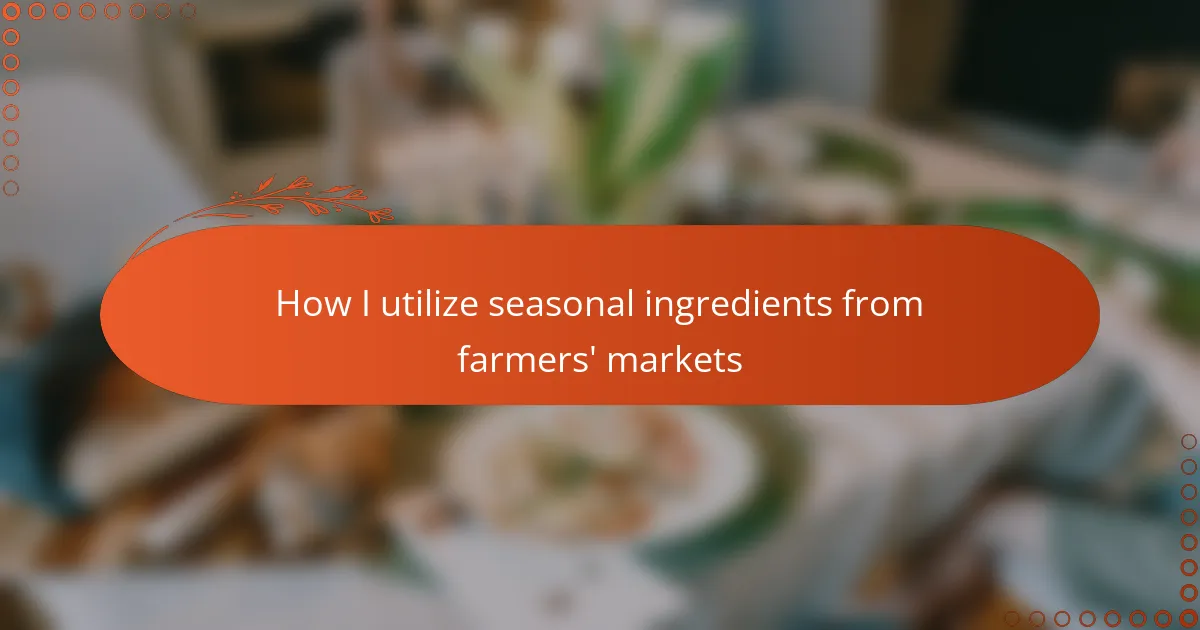Key takeaways
- Seasonal ingredients enhance flavor and connect us to the rhythms of nature, encouraging creativity in cooking.
- Shopping at farmers markets supports local economies, provides fresher produce, and fosters community connections.
- Preservation methods like freezing and canning allow us to enjoy seasonal flavors long after the harvest is over.
- Planning meals around seasonal recipes reduces food waste and keeps cooking exciting and innovative.
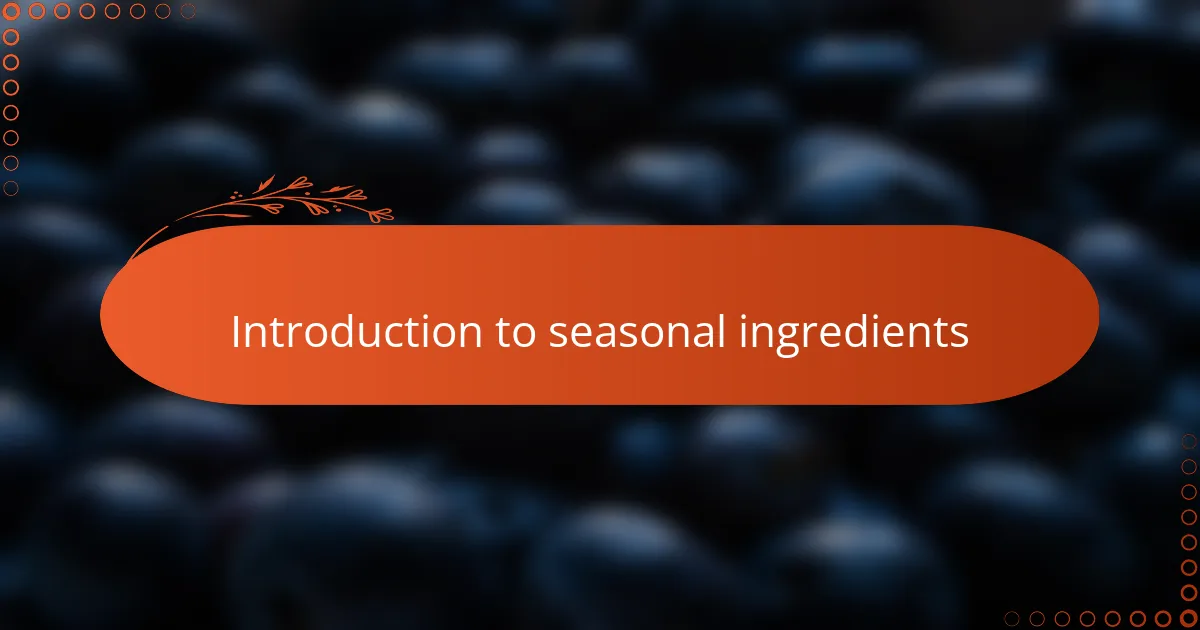
Introduction to seasonal ingredients
There’s something truly special about seasonal ingredients that instantly connects me to the rhythms of nature. Have you ever noticed how the flavors of food seem more vibrant and alive when they’re picked at their peak? It’s like tasting the story of the earth’s current chapter.
When I first started visiting farmers markets regularly, I was surprised at how much the selection changed week by week. This ongoing surprise sparked a new kind of creativity in my cooking—I began to see meals as celebrations of whatever bounty was at its freshest. Isn’t it amazing how seasonality can inspire both simplicity and innovation in the kitchen?
Using seasonal ingredients not only supports local farmers but also deepens my relationship with food. It reminds me that cooking isn’t just about nourishment—it’s about honoring the time and place each ingredient comes from. How often do we get to slow down and savor those connections in our busy lives?
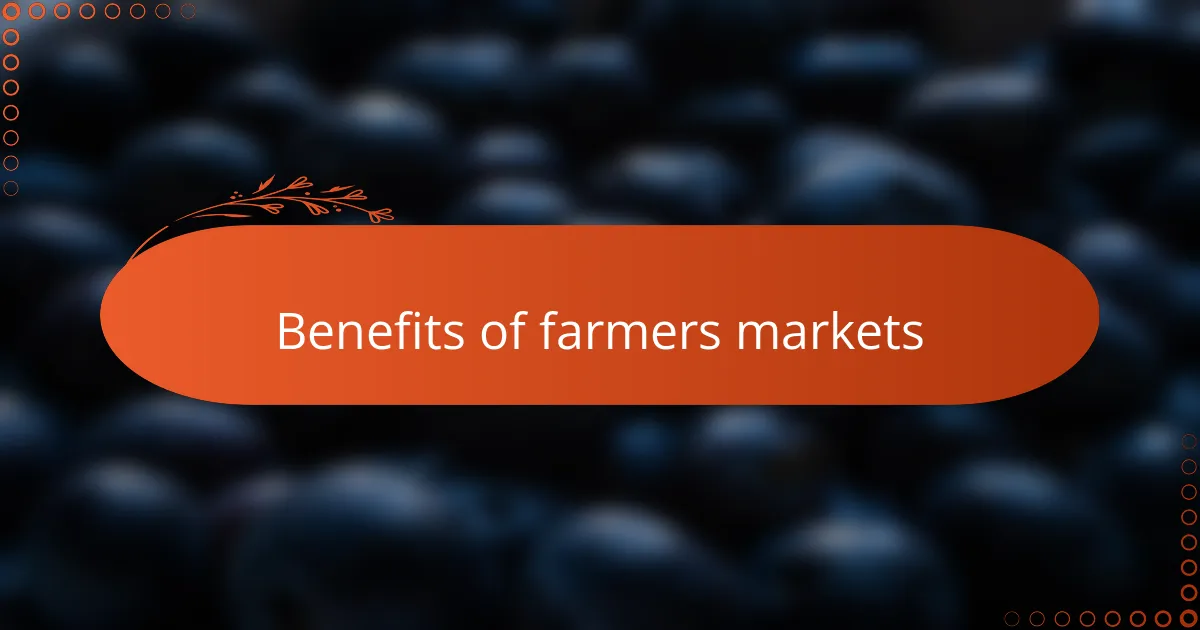
Benefits of farmers markets
There’s something about wandering through the colorful stalls at farmers markets that makes me feel connected—not just to the food, but to the community behind it. Have you ever chatted with a farmer who can tell you exactly when and where your tomatoes grew? That personal touch adds a layer of meaning I don’t find in grocery stores.
I’ve also noticed that the produce from farmers markets often tastes so much fresher, and that’s because it’s usually harvested just hours before I pick it up. This freshness translates into richer flavors and better textures, which makes my meals taste more vibrant without much effort. Isn’t it wonderful when quality meets simplicity?
Beyond just the food, shopping at farmers markets supports local economies and promotes sustainable agriculture. Knowing that my purchases help small-scale farmers keeps me coming back—it feels good to contribute to something bigger than myself while enjoying incredible ingredients. Have you felt that sense of purpose after a market trip? I certainly have.
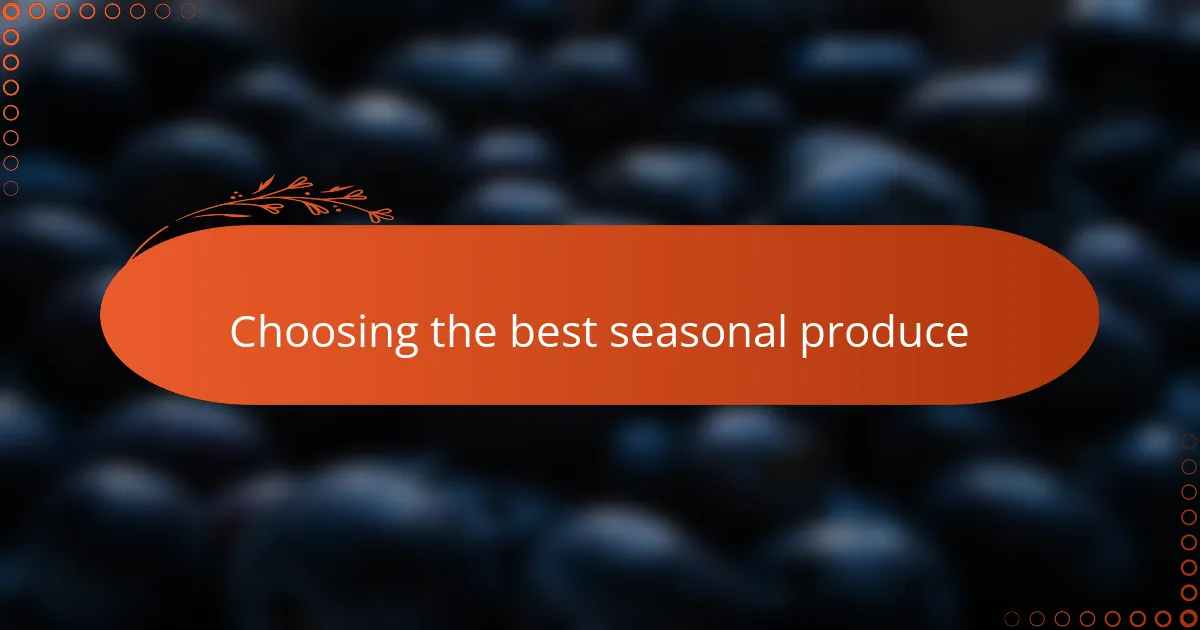
Choosing the best seasonal produce
Choosing the best seasonal produce often starts with a simple question: what looks and smells the freshest today? I remember one summer when the peaches at my local market were so fragrant that I couldn’t resist buying a bushel, even though I wasn’t sure what I’d make. That aroma told me they were picked just at the right moment.
I find that spending a few minutes chatting with the farmers themselves is invaluable. They often share tips on what’s truly in season and at its peak, and their enthusiasm is contagious—it makes me appreciate the care behind each basket of vegetables or fruit. Have you ever noticed how a quick conversation can transform your approach to selecting ingredients?
Sometimes, choosing the best produce means trusting your senses over perfect appearance. A slightly imperfect carrot or a misshapen tomato can pack more flavor than the most polished ones in the bin. I’ve learned to embrace those quirks; they remind me that real food grows in nature, not on a production line. Isn’t that a comforting thought?
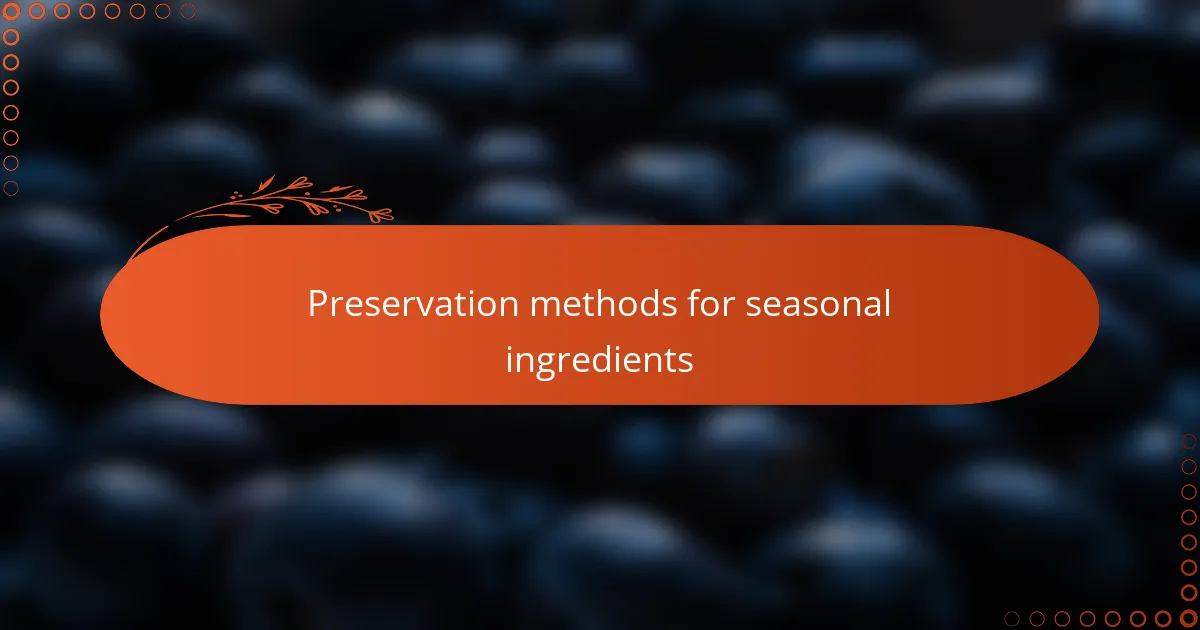
Preservation methods for seasonal ingredients
Preserving seasonal ingredients has become an essential part of my routine, especially when farmers markets overflow with ripe fruits and vibrant vegetables. Have you ever felt that bittersweet moment of wanting to enjoy every fresh bite immediately but knowing you need to save some for later? That’s where preservation methods like freezing, canning, and drying come in handy—they let me hold onto the flavors of the season long after the market stalls have emptied.
Freezing is often my go-to because it’s quick and retains so much of the original taste and texture. I usually blanch vegetables like green beans or zucchini first, which helps keep their color and nutrients intact. On the other hand, when the market brings an impressive mountain of berries, I find making jams and preserves deeply satisfying—it’s like bottling summer sunshine to brighten a winter day.
Drying herbs and even some fruits has also become a quiet ritual for me, one that fills the kitchen with warming aromas and a sense of accomplishment. Have you ever hung bundles of thyme or basil by your window, watching them slowly transform? It feels like a small gift, a way to stretch the joy of the season into months ahead while inviting a rustic charm into your home.
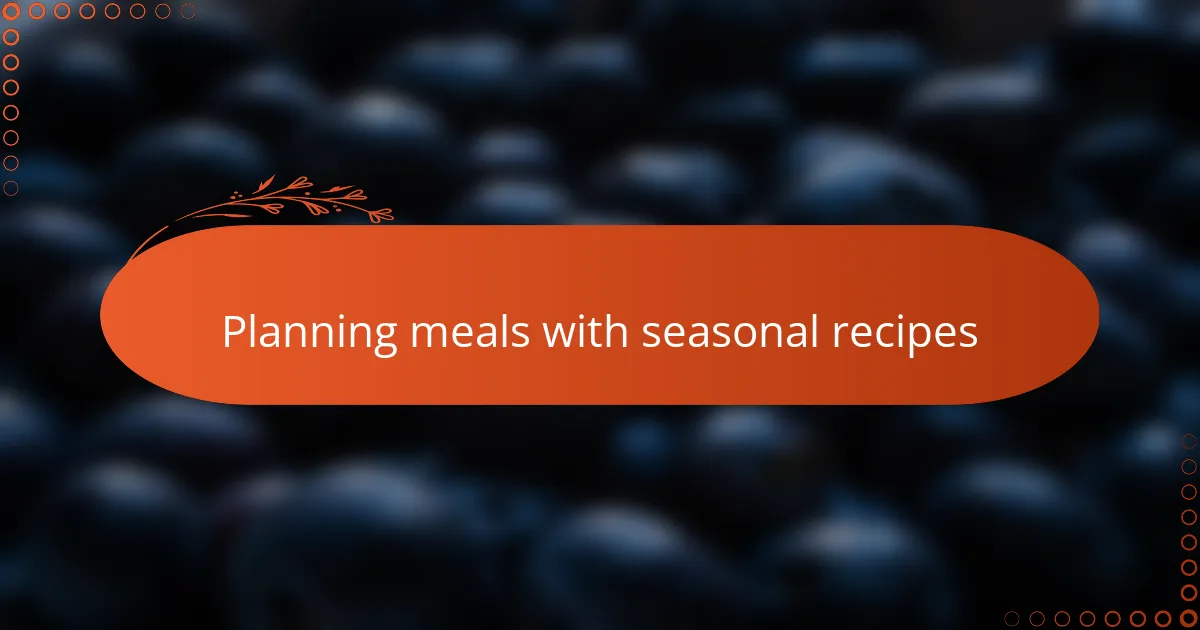
Planning meals with seasonal recipes
Planning meals around seasonal recipes feels like crafting my own little calendar of flavors. I often start by looking at what just arrived at the market and imagine how those ingredients can shine together on my plate. Have you ever noticed how the freshness of spring asparagus or the sweet juiciness of autumn squash can inspire completely different meals?
Sometimes, the unpredictability of seasonal availability challenges me to be flexible and inventive with my menus. I recall a time when an unexpected early harvest of tomatoes nudged me into making a batch of fresh salsa, even though it wasn’t on my original plan. That spontaneity keeps cooking exciting and makes each meal feel uniquely tied to the moment.
I’ve found that coordinating my shopping trips with meal planning saves me from food waste and maximizes flavor. Choosing recipes that highlight the current season’s best offerings turns cooking into a joyful practice rather than a chore. What seasonal dishes do you look forward to recreating each year? For me, it’s a ritual I can’t wait to repeat every season.
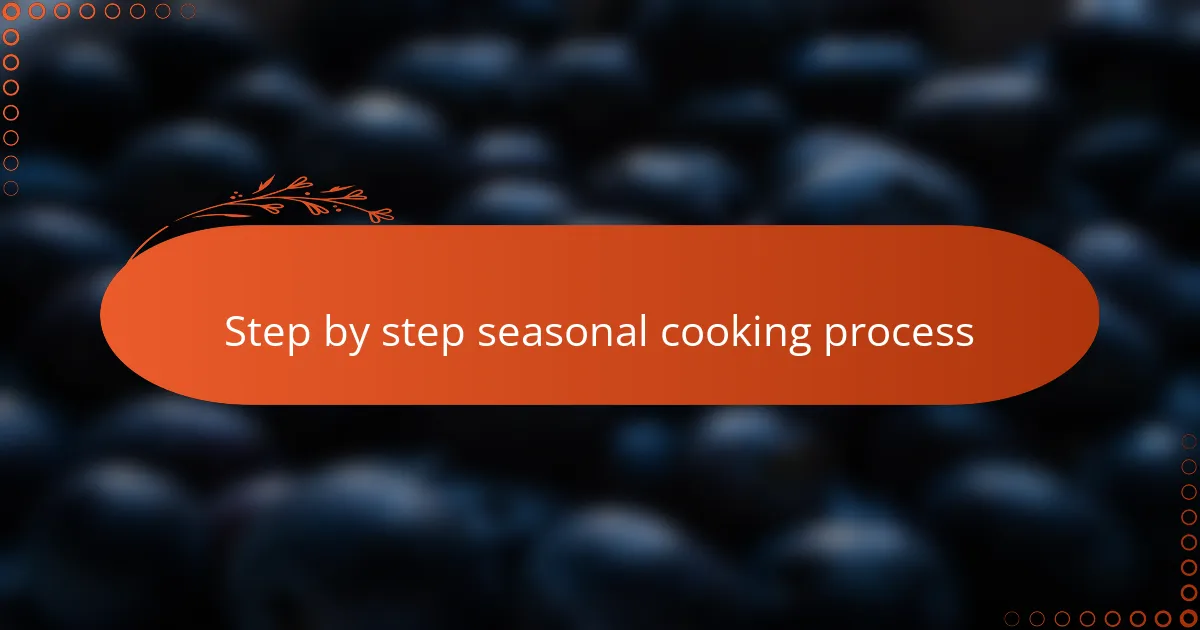
Step by step seasonal cooking process
The first thing I do when cooking with seasonal ingredients is to let the produce guide me. I find myself unpacking colorful crates and simply touching, smelling, and examining each item to decide what feels right for that day’s meal. Have you ever noticed how a perfectly ripe peach or a bunch of leafy greens just seems to whisper ideas for dishes?
Next, I focus on respecting the natural qualities of the ingredient—cooking methods that bring out their best without overshadowing their freshness. For example, roasting root vegetables slowly to caramelize their sweetness or lightly steaming greens to keep their vibrant color and crunch. It’s about letting the season’s story shine through each bite, rather than forcing flavors together.
Finally, there’s a rhythm to the process that I’ve come to appreciate: planning just enough so nothing goes to waste, but leaving room for spontaneity. Sometimes I start a soup with that morning’s freshest squash, and later decide to add herbs I picked up on a whim. Does that balance between structure and creativity keep your cooking exciting too? For me, it’s part of the seasonal magic.
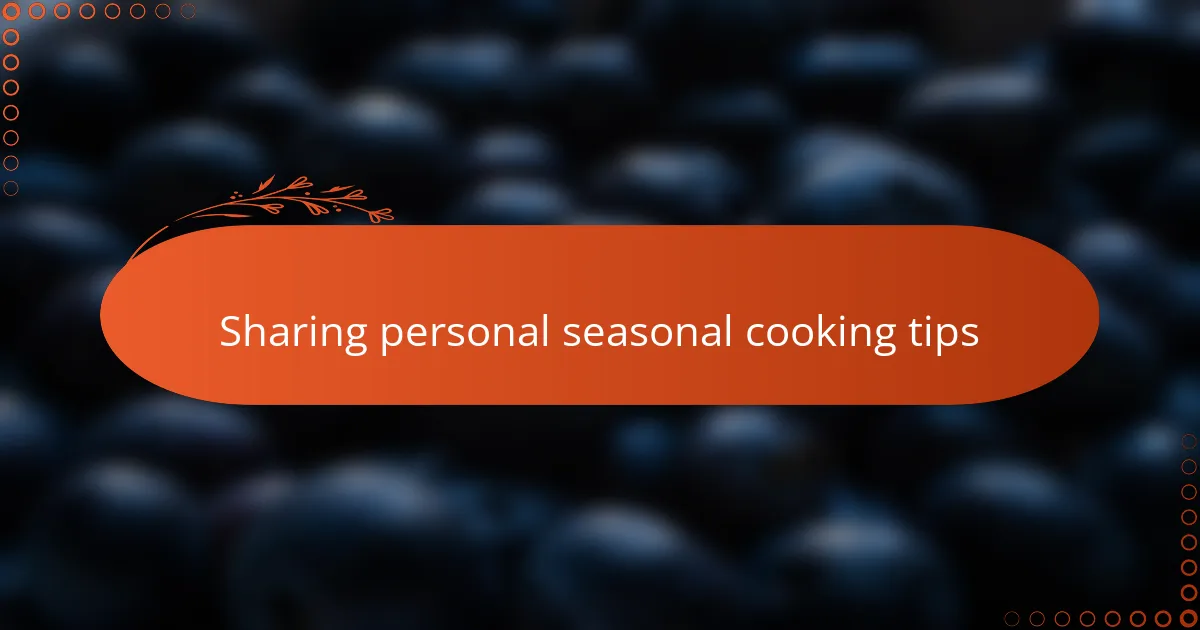
Sharing personal seasonal cooking tips
When I’m cooking with seasonal ingredients, I’ve learned to trust my instincts above all else. Sometimes, it’s as simple as letting the ripeness of a tomato or the fragrance of freshly picked basil dictate what the dish becomes. Have you ever noticed how trusting those little sensory hints often leads to the most satisfying meals?
I also find that embracing the quirks of seasonal produce makes cooking more joyful. A lopsided zucchini or a few bruised apples don’t bother me anymore—they tell me I’m working with real, natural food. This mindset shift has brought a new kind of appreciation and playfulness to my kitchen routine, turning challenges into opportunities for creativity.
One tip I always share is to keep meals flexible and open to change based on what’s freshest that week. There was one chilly autumn when a sudden abundance of pumpkins inspired me to experiment with savory stews and sweet pies I hadn’t planned. Isn’t it wonderful how seasonal surprises can spark fresh ideas and keep cooking adventurous?
